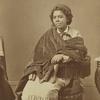More about Columbus

Contributor
In the pretty-darn-white, pretty-darn-male boys' club of Neoclassical sculptors, Edmonia Lewis was a Black, Native American woman — which made for some bumpy sailing careerwise.
After some tumultuous times in the States, including accusations of attempted murder of two fellow college students, Lewis headed to Rome to continue her sculpting career there, which is where she ended up making Columbus.
In this sculpture, Columbus appears to be holding some kind of sheet, making it look a bit as though he was on his way to do some laundry. In front of the fabric, there is Native American woman kneeling.The draping of the sheet around her body is a bit reminiscent of the Virgin Mary, or of a child who is dressing up as a ghost for Halloween— albeit a ghost wearing a Chipewyan headdress, the tribe of Lewis’ ancestors.
Lewis’ heritage is complicated and hard to prove, in part because she gave different stories to different folks and never stuck to just one version. It doesn’t help that there’s also all kinds of misinformation floating around her life story. But it’s likely that her mother was Chippewa and that she spent at least part of her childhood living with her mother’s tribe, and a good deal of her sculptures deal with Native American imagery. While it’s easy for modern day art folks to want to pigeonhole Lewis’ work as #feminist, the reality isn’t quite that simple. Several of her pieces, including Columbus, feature women in subservient positions to men, kneeling at their feet or staring up at them longingly or thankfully, occasionally with their hands clasped in prayer.
Since Lewis isn’t around today, there’s no way to know if these postures were choices she made out of irony, sincerity, or for the sake of her own economic and social security, as she was certainly aware of the (false) popular narrative of Columbus as a holy conqueror, and of the culture of white supremacy in the Eurocentric art world. That context should also be considered when looking at the features of the Native American woman in this painting, who looks pretty darn Caucasian— and not just because she’s sculpted from white marble. It’s likely that Lewis knew that European features would be better received by her white colleagues than a more accurate representation of Native features, but whether or not that knowledge determined her artistic choices, we’ll never really know.
Sources
- Edmonia Lewis. (n.d.). Retrieved April 23, 2021, from https://americanart.si.edu/artist/edmonia-lewis-2914
- Green, P. (2018, July 25). Overlooked No More: Edmonia Lewis, Sculptor of Worldwide Acclaim. Retrieved April 23, 2021, from https://www.nytimes.com/2018/07/25/obituaries/overlooked-edmonia-lewis-…
- Henderson, H. (n.d.). Edmonia Lewis. Retrieved April 23, 2021, from https://edmonialewis.com/blog.htm#McGraw











